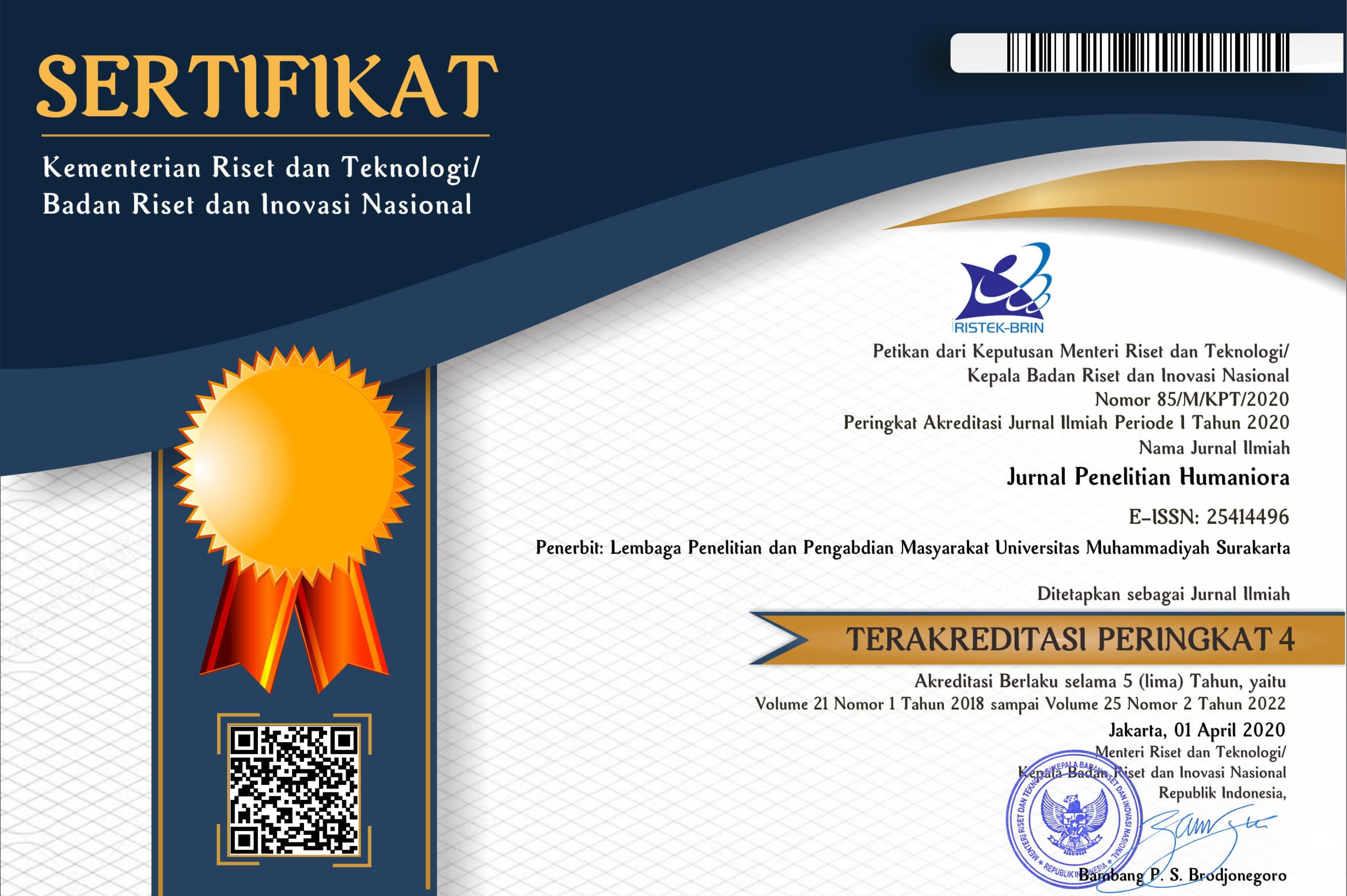STUDENTS’ COMPETENCE IN INTERPRETING DEIXIS IN DESCRIPTIVE TEXT ON PRAGMATICS COURSE OF ENGLISH LETTERS DEPARTMENTS OF UNIVERSITAS AHMAD DAHLAN IN 2017/2018
Garda Arif Wicaksono(1*)(1) Ahmad Dahlan University
(*) Corresponding Author
Abstract
This research is aimed to investigate the students’ competences in interpreting deixis in descriptive texts on pragmatics course and to find out the students’ difficulties in interpreting the types of deixis.
This research uses quantitative research which is conducted on the students who take pragmatics course in English Letters Department of Universitas Ahmad Dahlan. The data are taken through a test. The instrument of test validity was assessed by the experts. The test is used to measure the students’ competence in interpreting deixis. To measure the reliability, this research uses Alpha formula. The data are analyzed using descriptive statistics.
Based on the research finding, it can be concluded that the students’ competence in interpreting deixis in descriptive text is good to excellent. The result can be concluded as follows; (1) person deixis is good (50%); (2) time deixis is excellent (55%); (3) discourse deixis is excellent (45%); (4) social deixis is excellent (55%), and (5) place deixis is good (55%). The most mistakes which are done by students in interpreting deixis occur in discourse deixis. The cause of them can be; (a) having limited vocabularies; (b) less understanding the context of descriptive text; (c) difficult to comprehend the situational information in the descriptive text.
Keywords
Full Text:
PDFReferences
Agustin, V. (2012). Kompetensi Lulusan Sarjana Strata 1 (S1) Psikologi dalam Menghadapi Dunia Kerja pada Mahasiswa Perguruan Tinggi X. Jurnal Ilmiah Mahasiswa Universitas Surabaya, 1(1). Retrivied from: https://media.neliti.com/media/publications/186931-ID-kompetensi-lulusan-sarjana-strata-1-s1-p.pdf
Bachtiar, B.M, Cicik.K. (2005). Let’s Talk.Bandung: Pakar Raya.
Cholid, N., & Abu, A. (2003). Metodologi Penelitian. Jakarta, Bumi Aksara.
Fromkin, V., Rodman, R., & Hyams, N. M. (2007). An introduction to language. Boston, MA: Thomson Wadsworth.
Furchan, A. (2004). Pengantar Penelitian dalam Pendidikan. Yogyakarta: Pustaka Pelajar
Huang, Y. (2007). Pragmatics. United States: Oxford University Press.
Hurford, J., Brendon, H., & Michael, B.S. (2007). Semantics: A Coursebook. Cambridge University Press.
Jamaris, M. (2014). Formal multiple intelligences assessment instruments for 4-6 years old children. American Journal of Educational Research, 2(12), 1164-1174.
Johnson, B., & Christensen, L.(2008). Educational research: Quantitative, qualitative, and mixed approaches. Thousand Oaks, CA: Sage Publications.
Leedy, P.D.(1993). Practical Research: Planning and Design. 5th ed. New York: Mackmillan Publishing Company.
Levinson, Stephen C. (1995). Pragmatics. Cambridge: Cambridge University Press
Maximilian, A., &Ajeng, G.D. (2013). Pragmatics in Language Teaching. Yogyakarta: Deepublish.
Nassajai, H. (2015). Qualitative and descriptive research: Data type versus data analysis. Language Teaching Research. 19. 129-132. 10.1177/1362168815572747.
Sugiyono, (2012). Memahami Penelitian Kualitatif. Bandung: ALFABETA
------------.(2013).Metode Penelitian Pendidikan (Pendekatan Kuantitatif, Kualitatif dan R&D, Bandung : Alfabeta
Uzer, U.(2006). Menjadi guru profesional. Bandung: Rosda.
Yule, G. (2005). Pragmatics. New York: Oxford University Press
Yule, G. (1996). Pragmatics. New York: Oxford University Press
Article Metrics
Abstract view(s): 576 time(s)PDF: 728 time(s)











